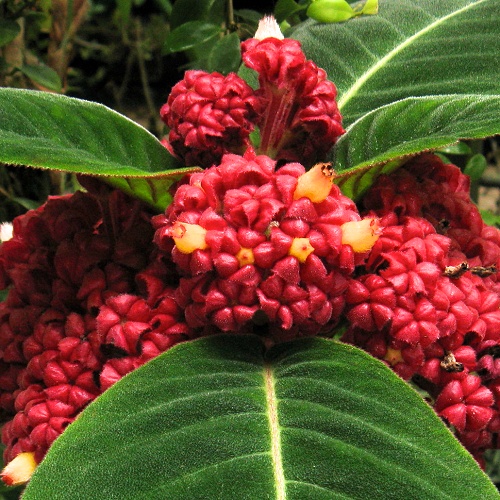Germinating the seeds
If you have germinated Begonia seeds or tiny Gesneriad seeds before, you may use the same technique that worked for you, because germination is similar. The method below works for me. Getting started -- Plant your seeds when you receive them for best results. Use small pots or cups with drainage holes, about 2-3 inches (5-10 cm) tall. Use well-draining soil. I use a mix of 1
part
coir fiber The seeds are very small, so work in a well-lit area. Sprinkle several seeds evenly across the surface of each pot. An easy way to pick up the seeds is by breathing on your finger tip to lightly moisten it, then dabbing the seeds with it. Don't sow them too densely, because the germination rate is high. If you have long-fiber sphagnum moss (not ground peat moss), sprinkle a little over the surface. This helps retain moisture around the seeds while allowing light to reach them, which aids germination. This photo shows how much moss to use. If you don't have sphagnum moss, sprinkle some of your soil mix over the surface. Then add water until everything is evenly moist. Until the seeds sprout, ensure that the soil surface never dries out. You can maintain high humidity by enclosing the pots in a plastic container or bag - just leave it open a crack to let in fresh air. Once or twice a day, drip a few drops of water on the surface to keep it moist. The seeds germinate well between 68-80 degrees
F (20-27°C) during the day, and a little cooler at night. I don't have
experience germinating them outside this temperature range. I recommend
placing a
minimum/maximum thermometer Place the containers in a bright spot out of direct sun. A fluorescent or LED bulb kept 4 inches (10 cm) above them provides the right amount of light. They should start sprouting in 3-4 weeks, but may take up to 6 weeks. Continue dripping water on the soil surface the first month after they sprout, since young seedlings have a small root system. Fertilizing -- The first
3 months weeks, feed every 7 days with a very dilute (1/8 strength) liquid fertilizer. Hydroponic fertilizer is ideal for this, because it is easily absorbed and contains all essential nutrients. I use General Hydroponics Flora fertilizer Watering -- Once the seedlings are a month old, you may stop keeping the soil surface moist at all times. Aim to keep the rest of the soil evenly moist (but not soggy). Lighting -- It likes bright, filtered light, with protection from strong sun. Climate -- It grows well for me in mild to warm conditions with a drop in temperature at night, similar to intermediate-temperature orchids. I'm unsure how it will do in hot conditions with warm nights. I'm pretty sure it can't survive frost. It prefers relatively humid air - over about 50% humidity is best. If your plants seem to suffer from low humidity indoors, consider using an ultrasonic humidifier. When the seedlings are 2 months old, you may carefully dig them up and transplant them, or cut off any slower ones, and leave 1 strong seedling in each pot. If you have any questions or problems, feel free to contact me. Have fun growing them! - Jeff Strange Wonderful Things
|
|||||||||


